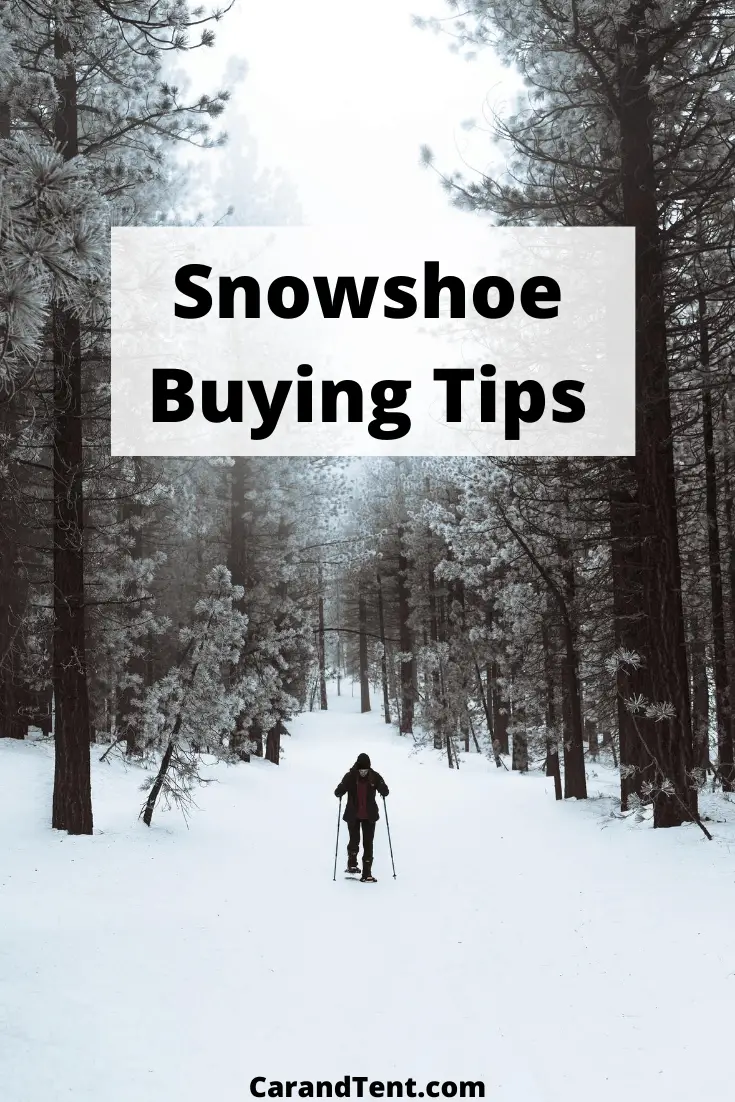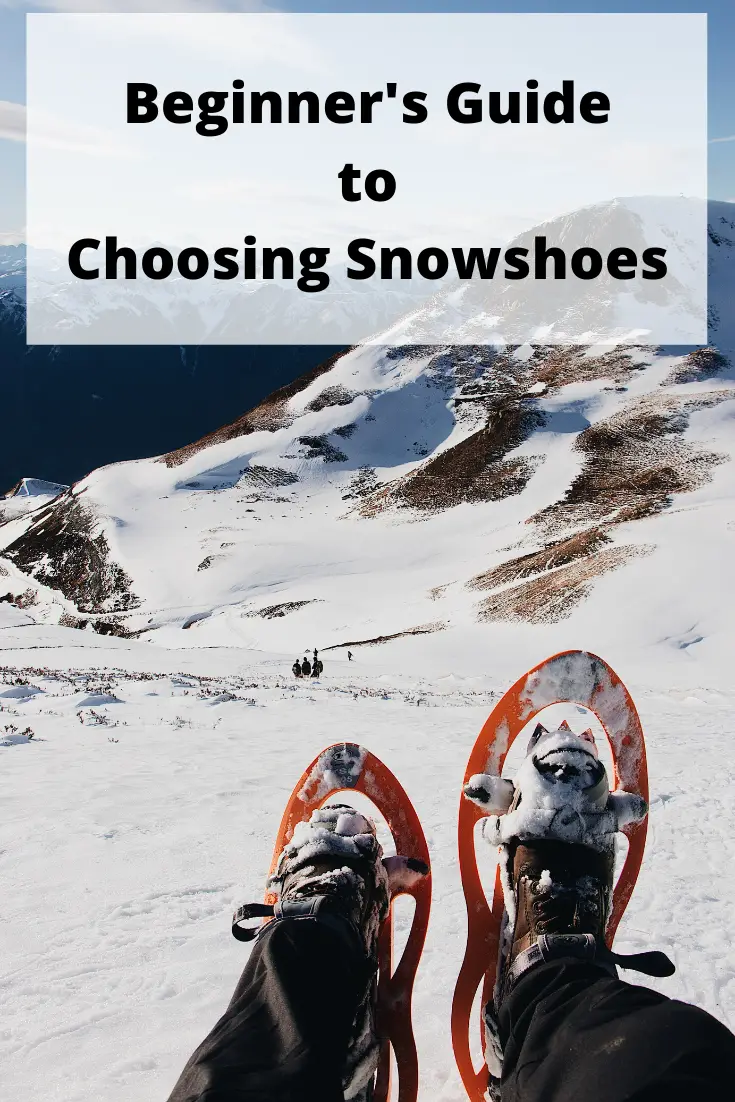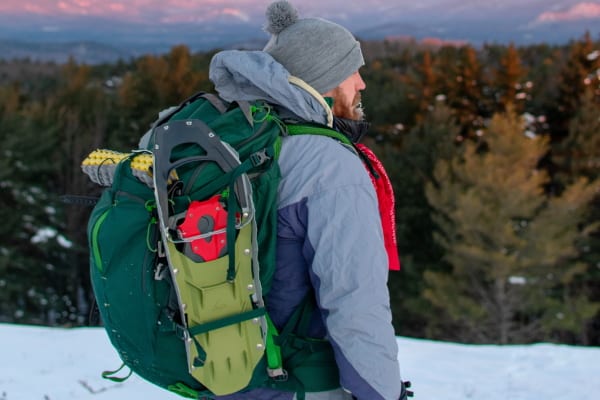
Choosing a pair of snowshoes isn’t that complicated but there are some things you need to know. There are different snowshoe types, builds, sizes, and of course, brands.
In this post, we’ll go over these different factors so that you can choose the perfect snowshoes for you.
Table of Contents
The Anatomy of a Pair of Snowshoes
In the old days, a pair of snowshoes might consist of some pine branches and some twine. This was just enough to provide the wearer with some flotation so that he didn’t sink into the snow.
These days, however, snowshoes have a bit more going for them and as a result, you can do a lot more with them. A typical modern-day snowshoe will consist of a frame, decking, binding, and crampons. It may also have cleats, heel lifts, and braking bars.
The front deck of the snowshoe will be wider than the rear deck and the rear may or may not end with a tail. Some snowshoes will even have a tail that can be added or taken off when needed. Different models will have slightly different binding methods but generally, bindings will consist of pull bindings at the toe area and straps at the heel.
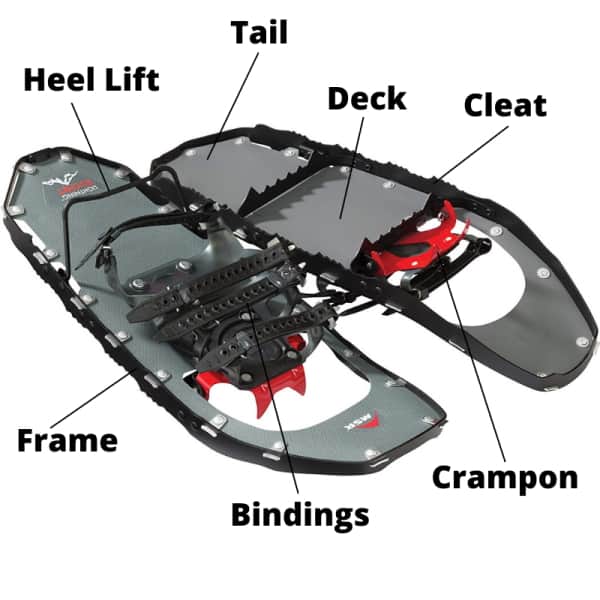
Here is what each part of a snowshoe does.
The Frame – Snowshoe frames act as the skeleton of the snowshoe. They create the basic shape of the snowshoe. All other parts of the snowshoe will connect to either the frame or the decking.
Snowshoe frames used to be made from wood or in some cases, bones. These days, they’re either made from aluminum or a composite frame. Aluminum is usually the more traditional choice, but some of the hard plastic composites are starting to look promising.
The Decking – The deck of the snowshoe is what provides flotation. Flotation is simply the act of sitting on top of the snow rather than sinking through it.
In the past, the deck may have consisted of tree branches, rope, or rawhide. These days, the deck is usually made from some sort of synthetic material. This decking will usually be connected to the frame using straps and grommets.
You may also find snowshoes that consist of a solid composite that makes up both the frame and the decking. This type of decking makes it easy to create a snowshoe with a removable tail.
The Tail – Snowshoe tails are usually rounded or pointed. Assuming the length of the snowshoes is equal, rounded tails will provide more flotation. This makes them better for deep or powdery snow.
Pointed tails, on the other hand, are easier to maneuver with. People are less likely to trip over a pointed tail and the design helps keep snow from accumulating on the rear deck.
Bindings – Snowshoe bindings keep your snowshoes attached to your boots. They consist of straps upfront that fit over your toe box and a strap at the back that cradles the back of your heel. The front straps are similar to drawstrings and the rear straps usually work like a ratchet strap or a belt.
Crampons – Crampons ensure that the snowshoe will grip the snow and ice. They work well on flat ground and excel when walking over un-level terrain.
There is almost always a crampon located under the front section of your feet and there is usually a second crampon further back towards the rear of the snowshoe. This rear crampon is often referred to as a brake bar.
Some racing snowshoes will not have any crampons.
Cleats – Cleats, sometimes called traction bars, can add additional traction to snowshoes. These cleats will run along either side of the snowshoe and are usually attached directly to the frame. Not all snowshoes will have cleats.
Now that you know the anatomy of a snowshoe, let’s take a look at the different types of snowshoes.
Heel Lifts – Heel lifts are small retractable devices that can be flipped up to help lift your heels. These are sometimes referred to as climbing bars or televators. People who often traverse steep inclines often find these useful as it makes traversing hills a little easier.
Types of Snowshoes
There are three main types of snowshoes to choose from. These are recreational snowshoes, racing snowshoes, and backcountry snowshoes.
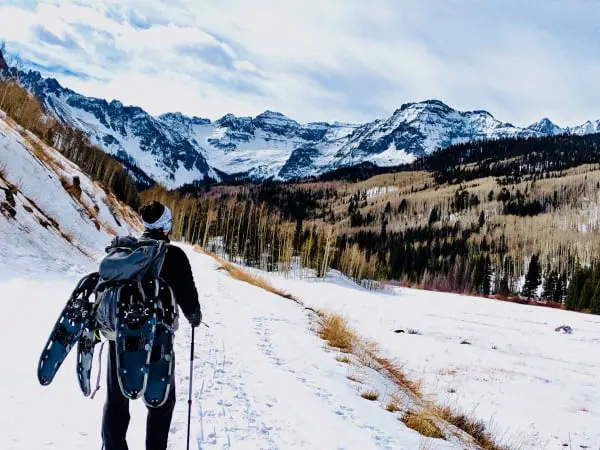
Recreational Snowshoes
Recreational snowshoes are also called trail snowshoes. These snowshoes are easy to use and are typically less expensive than racing or backcountry snowshoes.
A recreational snowshoe will usually have a pointed tail and a smaller length and width. This means it won’t have as much flotation as a backcountry snowshoe but it will be easier to maneuver through designated hiking trails.
These snowshoes are the most versatile and can be used on trails and in less rugged backcountry areas. By less-rugged, I mean backcountry areas with gently rolling hills and snow that is easy to walk through.
Backcountry Snowshoes
Backcountry snowshoes will often have rounded tails and they’ll be a bit longer and wider than recreational snowshoes. They may also come with additional features like cleats and heel lifts.
The larger size of backcountry snowshoes makes them great for traversing areas with deep snow. Cleats and heel lifts add additional stability and make it easier to get up and down steep hills.
Get backcountry snowshoes when you intend to go deep into the wilderness or through areas with high elevations. Also, consider using them on backpacking trips as they’ll be able to support the added weight of your pack better than a pair of recreational snowshoes would.
Racing Snowshoes
Racing snowshoes are smaller than the other types of snowshoes. They are built for quick movement through shallow snow. These snowshoes are perfect for people looking to do some winter trail running on their favorite, but snow-covered trails.
Of course, this type of snowshoe has its disadvantages. For starters, don’t expect to be able to get through areas with deep powdery snow. These snowshoes don’t have a lot of flotation so you’ll just end up sinking deep with each step you take.
Also, don’t expect steep inclines to be easy in a pair of racing snowshoes. You may find that your racing snowshoes don’t even have crampons or cleats so you won’t get much additional traction from wearing them.
Snowshoe Sizes
There are men’s snowshoes, women’s snowshoes, kid’s snowshoes, and unisex snowshoes. However, the main thing you’ll want to look for is how much weight the snowshoe is rated to handle.
Snowshoes typically come in weight ranges that you can use to gauge whether or not they’ll work for you. For example, a pair of snowshoes might be rated for people who weigh between 150 and 200 pounds.
These snowshoes will also come in a length as well. For instance, one pair of snowshoes that are rated for 150 – 200 pounds might have a 25″ length while another model might have the same weight rating but it will have a length of only 23″.
When deciding on a pair, make sure you take the weight of your gear into account as well. If you’re 190 pounds and you plan on carrying a 25-pound backpack, the 150 – 200 pounds rated snowshoe will not work for you and you’ll want to get the next model up.
As far as the weight of the snowshoes themselves, you can expect a pair of adult snowshoes to weigh between 3 to 6 pounds. This doesn’t sound like a lot but remember that this weight is located on your feet so you’ll definitely feel the difference between a pair of 4-pound snowshoes and a pair of 6-pound snowshoes.
Snowshoe Brands
There are entirely too many snowshoe brands on the market to name them all on this post. However, the industry leaders tend to be Redfeather, MSR, Yukon Charlie, Atlas, and Tubbs.
I’ve reviewed the pair of Atlas snowshoes that I bought several years ago on the post titled, “Atlas 930 Snowshoe Review“. This was a good pair of beginner snowshoes but if I had to buy some now, I’d probably go with one of the new MSR snowshoes with the modular tail.
The reason I’d choose this snowshoe is that it comes in a shorter length which is perfect for trail hiking and hiking through shallow snow. If and when you need a longer snowshoe, you just pop the modular tail on the back and you add another 6” to each shoe. You can see an example of what I mean on Amazon, through my affiliate link here.
Snowshoe Poles
Snowshoe poles aren’t always needed when snowshoeing but they can make snowshoeing a lot easier and safer. These poles also have their own anatomy to consider. A snowshoe pole will consist of a grip, a strap, a shaft, a locking mechanism, a basket, and a tip.
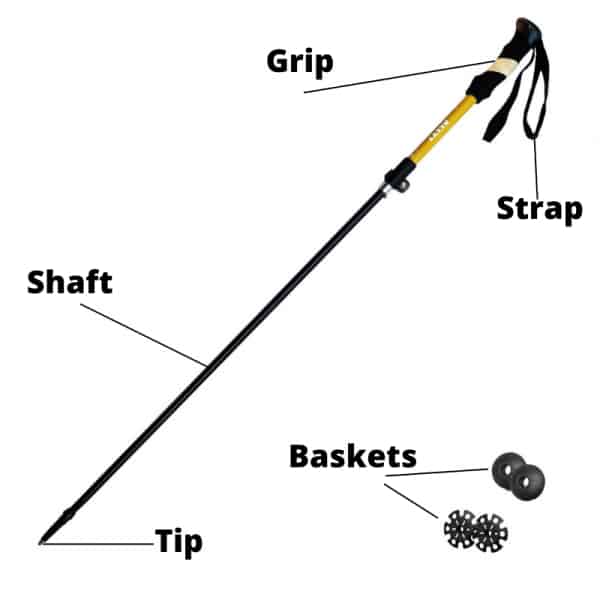
The Grip – The grip of a snowshoe pole is typically made from rubber, foam, or cork. Some people feel that rubber grips are best for snowshoe poles as they do not get as cold.
The Strap – The strap, also known as a wrist wrap is made of synthetic material. You can get them with padding or without. Since you’ll have gloves on anyway, it makes little sense to worry about whether or not they’re padded.
The Shaft – The shaft of a snowshoe pole is either made of aluminum or composite material. Composites tend to weigh less than aluminum poles but they also cost more.
The Locking Mechanism – Adjustable shafts will have a locking mechanism in them to keep them in place.
The Basket – Snowshoe poles will have larger baskets with holes spread throughout them. This helps the pole move through soft snow.
The Tip – The tip of a snowshoe pole could be made from composite or metal. These tips can be replaced if they become damaged.
If you already have trekking poles for hiking, you already have everything but the basket. Just get a snowshoe pole basket and put it on your trekking pole. Otherwise, I’d recommend buying a pole that allows your elbow to be at a 90-degree angle when using it. Go with a rubber grip for its insulating properties and make sure you get a snowshoe basket with it.
Final Thoughts
Now that you know how to buy snowshoes and snowshoe poles, all that’s left for you to do is to decide which ones you want. Just remember when comparing shoes that some manufacturers will use different terms for different parts so if you get confused, just come back here and check out the anatomy sections and you won’t have any trouble making the right comparisons.

